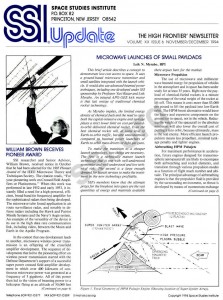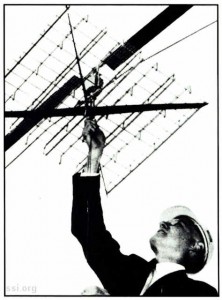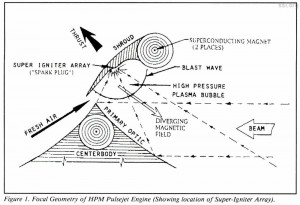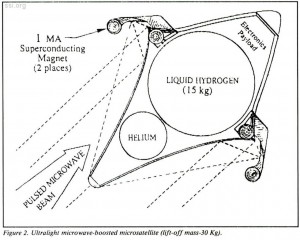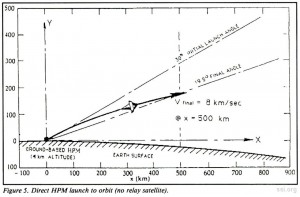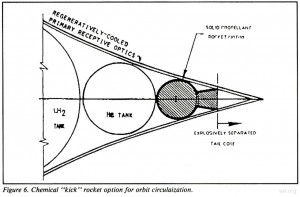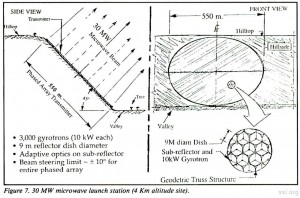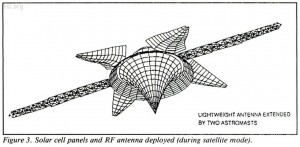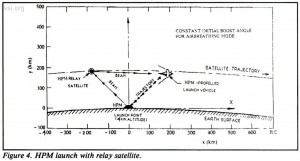SPACE STUDIES INSTITUTE
P.O. BOX 82
PRINCETON, NEW JERSEY 08542
[[librarian note: This address is here, as it was in the original printed newsletter, for historical reasons. It is no longer the physical address of SSI. For contributions, please see this page]]
THE HIGH FRONTIER® NEWSLETTER
VOLUME XX ISSUE 6 NOVEMBER/DECEMBER 1994
WILLIAM BROWN RECEIVES PIONEER AWARD
SSI researcher and Senior Advisor, William Brown, received notice in October that he had been selected for the 1995 Pioneer A ward of the IEEE Microwave Theory and Techniques Society. The citation reads, “For your pioneering work on Crossed Field Amplifiers or Platinotrons.” When this work was performed in late 1952 and early 1953, it instantly filled a need for a high-powered, efficient, broadband (in frequency) amplifier for the sophisticated radars then being developed. The microwave tube found application in air route surveillance radar, and notably in defense radars including the Hawk and Patriot Missile Systems and the Navy’s Aegis system. An example of the versatility of the device is its use in the high data rate communication link, including video, between the Moon and Earth in the Apollo Program.
In the context that one development leads to another, microwave wireless power transmission is an offspring of the crossfield amplifier development. The sequence of developments that led to the pioneering effort on wireless power transmission started with the Defense Department’s support of a successful super power crossed field amplifier development in which over 400 kilowatts of continuous microwave power was generated at a frequency of 3 gigahertz. All of this power then led to the vision of beaming power to a helicopter flying at an altitude of 50,000 feet and performing communication and surveillance functions.
As a preliminary step toward this end, power was beamed to a small microwavepowered helicopter at the Raytheon Company in October 1964, and shown on the CBS news programs. This public demonstration of wireless power transmission is generally considered to have been the event that established an awareness of wireless power transmission and its potential applications within the electronic and aerospace communities.
This demonstration led to an initial interest within NASA in applying wireless power transmission to space activities. It became an active development activity in NASA after a meeting with Wernher von Braun and his staff following a small demonstration of wireless power transmission to them in 1968.
In 1968, Dr. Peter Glaser published his concept of the Solar Power Satellite with microwave power transmission to Earth. This application had a major impact upon the direction that technology development took, most notably the development of electronically steerable phased arrays composed of many modules that used relatively low power tubes instead of the super power tubes. Currently, the best approach to meeting all the requirements needed for microwave power generators in the Solar Power Satellite, as well as for some other power transmission applications, is the magnetron which has been converted into a high-gain, phase-locked amplifier with the use of external circuitry.
And so, in the context of one development leading to another, the development of generators for wireless power transmission has gone full circle from magnetrons, to crossed field amplifiers, to super power crossed field amplifiers, and then back to magnetrons that have been converted to magnetron directional amplifiers to be used in ESPAMS or “electronically steerable phased array modules.” One of these ESPAMS is currently being demonstrated in the power beaming demontrations being sponsored by SSI.
MICROWAVE LAUNCHES OF SMALL PAYLOADS
Leik N. Myrabo, RPI
This brief article describes a concept to demonstrate low-cost access to space. It uses a ground-based microwave transmitter and small satellites integrated with the launch vehicle. It would also use advanced beamed power techniques, including one developed under SSI sponsorship by Professor Yuri Raizer and Leik Myrabo. An integral APO GEE kick motor is that last vestige of traditional chemical rocket technology.
As Myrabo implies, the limited energy density of chemical fuels and the need to carry both the capital-intensive engine and tankage places a strict lower limit on cost-per-poundto-orbit delivered chemical rocket. Even the best chemical rocket will, at some level of Earth-to-orbit traffic, become uneconomical compared to beamed power launchers or Earth-to-orbit mass-drivers or light gas guns.
To make the transition to a cheaper launch technology, two things are necessary. The first is a technically mature launch technology that is one with well-understood economics and well-understood and low technical risk. The second is a large enough demand for launch services to make the investment in the new technology profitable.
SSI’s members know that the ultimate prizes for the breakout into space are the vast quantities of energy and materials available there argues here for the market.
Microwave Propulsion
The use of microwave and millimeter wave beamed energy for propulsion of vehicles in the atmosphere and in space has been under study for at least 35 years. Right now the payload of chemical-fueled rockets is a minute percentage of the total weight of the rocket at lift-off. This means it costs more than $3,000 per pound to lift the payload into low-Earth orbit. The HPM-boost alternative would leave the heavy and expensive components on the ground (or in space), not in the vehicle. Reducing the weight of the spacecraft to the absolute minimum will also lower the overall cost of putting it into orbit, because ultimately, mass is the real enemy. More efficient launch propulsion means less propellant, minimal tankage penalty and lighter engines.
Airbreathing HPM Pulsejets
For maximum performance in acceleration, future engines designed for transatmospheric aerospacecraft are likely to encompass both airbreathing and rocket elements, and transition through various propulsion modes as a function of flight mach number and altitude. The principal advantage of airbreathing engines is that the propulsive fluid is provided by the surrounding environment, so thrust is developed by means of momentum exchange with the atmosphere. In contrast, rocket engines require that all the propellant be carried aboard the vehicle.
The airbreathers we are most familiar with are the gas turbine power plants that propel jet fighters and transport aircraft. The basic turbojet, perhaps the simplest turbomachine, operates on the Brayton thermodynamic cycle and requires an inlet diffuser, compressor, combustor, turbine and nozzle to generate thrust. Beyond Mach 2 (i.e., twice the speed of sound), the heavy mechanical compressor becomes a useless steel anchor because the compression function is now provided by the supersonic air ramming into the inlet.
In sharp contrast with such turbomachines, the basic ramjet configuration can be likened to a flying “stovepipe,” open at both ends, with a variable geometry air inlet and rear exhaust nozzle; in the center of this engine, combustion of the fuel takes place at subsonic (engine air) velocities. Ramjet engines and their supersonic-combustion counterparts (i.e., scramjets) have a great liability in that they cannot develop thrust at subsonic flight speeds. All need some kind of boost engine to get them started; e.g., rockets or turbomachines which can add significant weight and complexity to the flight platform.
However, there is one variety of “flying stove-pipe” engine which can produce significant thrust levels from a standing start – the pulsejet engine. Unlike the Brayton cycle engines, which are classified as “constant pressure” machines because at any engine station the pressures are constant with time (at a fixed throttle setting), the pressures anywhere within pulsejet engines fluctuate with time at a constant rhythm.
Chemical-fueled pulsejet engines have been built to operate in both combustion and detonation modes, although we are most familiar with the former. The first practical application of airbreathing pulsejet engines appeared with the German V-1 “Buzz Bomb” developed during World War II to rain terror over London, England.
A recent resurgence of interest in Pulsed Detonation Engines (PDE) indicates airbreathing pulsejet research is alive and well (Ref. 1). Some experts believe that PDEs are the short path to ultra-high performance supersonic and hypersonic acceleration engines of the future.
The role of the high-power microwave beam in a pulsejet engine is as an external ignition/detonation energy source. The propulsive microwave beam is transmitted to a receiving antenna on the spacecraft, where it is focused directly into the HPM pulsejet engine (Fig. 1). The thrust surface is equipped with a “super-igniter array,” which consists of a large number of wires imbedded vertically into the surface. These wires act as dipoles and are tuned to the HPM wavelength. The igniter array brings about electrical air breakdown by acting as a spark plug in the air breathing propulsion system.
Vehicle Description
In this design, the engine is integrated with the receptive optics and spacecraft airframe – including propellant tank, pressurization and delivery system, as well as electronics, communications and control systems. Designs for a small “Lightcraft Technology Demonstrator” have been developed in connection with a recent government-sponsored advanced propulsion program based on lasers (Ref. 2). A similar “ultralight” rnicrospacecraft can be developed for use with a lower power groundbased microwave boosting station (see Fig. 2). Liquid hydrogen would be used for the microwave-heated rocket propellant.
The HPM-boosted spacecraft can be kept light by fabricating a pressurized tensile structure to serve as a “backbone” to the craft. The most advanced high-temperature carbon composites would be used. A sandwich structure with a thermal insulating core material might be used to inhibit frost or ice formation on the optical receiving antenna. The innermost layer of tank could be a thin aluminum skin as a vapor barrier. A protective coating of silicon carbine must be applied to the exterior optical surface as protection from the oxidizing high temperature engine exhaust.
Launch Scenarios
Launch of this ultralight, 15 Kg. spacecraft involves several steps:
• An initial velocity is given by a compressed air cannon using a sabot which quickly separates from the vehicle.
• At one second into the launch, the pulsejet engine is engaged and the vehicle climbs at a fixed angle. With the airbreating engine, only a small amount of liquid propellant is consumed as coolant for the reflector and hot sections of the engine. The vehicle accelerates toward Mach 5. With higher speeds and lower air pressure (due to increased altitude), the amount of thrust will decline. At 30 Km altitude the airbreathing pulsejet engine is shut off.
• The vehicle coasts upward through the region of the Paschen minimum pressure. At the desired altitude the craft pitches over into its final horizontal position, and begins to receive microwave power from a low-altitude relay satellite (see Fig. 4). The rocket begins again to increase speed to that needed for a circular orbit.
An alternate launch scenario in Fig. 5 portrays a direct boost to low-Earth orbit velocity without invoking an expensive spacebased asset (i.e., the microwave relay satellite). This concept requires only the addition of a small “chemical kick” rocket to circularize the microspacecraft’s orbit once the perigee is reached (see Fig. 6).
Further improvements in transatmospheric acceleration performance might be enabled by an “Air Spike” device (described in the Sept/ Oct 1992 issue of SSI Update) to greatly reduce aerodynamic drag on the spacecraft forebody.
HPM Boost Facility The ground-based boost facility for HPM transmission is seen as a phased array of independently phased elements which produces a converging and concentrated beam (see Fig. 7) upon the spacecraft. A recent collaborative technical paper (Ref. 3) with J. Benford (Ref. 4) examined this innovative launch system, and identified a beam power requirement of 30 MW to boost a 30 Kg spacecraft needing 15 Kg of liquid hydrogen.
A transmitter aperture of 550 m and frequency of 220 GHz (an ideal atmospheric window) are necessary to focus power onto a 1 m diameter spacecraft receiver at a maximum range of 500 to 800 km – where orbital velocity is finally attained. A fixed array of slotted waveguide radiators might be preferred over a series of individual dishes for the transmitter. Gyrotrons appear to be the most promising millimeter wave sources, for which the present state of the art is 10 KW per device. In the near future, this average power level is expected to grow to 100 KW. Hence, 300 to 3000 sources are required to meet the 30 MW average beam power.
Applications
The next major revolution in communications may be within our reach: liberation from control of communication channels by large telephone companies or governments. Individual ownership of communication satellites – for business or pleasure – could cost no more than $21,000!
This revolution may come through the ability to launch 35-pound microsatellites (slightly heavier than the 31 lb. Explorer 1 launched into orbit by the U.S. on Jan. 31, 1958), with the aid of a 30 megawatt groundbased microwave launch facility developed with private resources. The difference between 1958 and today is that these specialized microsatellites are designed to carry 7 pounds of ultra-sophisticated modern microelectronics linked to a one-meter diameter telescope that can simultaneously act as a narrow band optical transceiver (see Fig. 2).
The satellite itself could cost just $15,000, and the microwave launch fee only $6000 more – for a total investment roughly equal to a new automobile or top-end microcomputer today. Custom features could be ordered to augment the basic package of a 75-watt solar panel, 20-watt-hr. rechargeable battery, communications/ guidance electronics, magnetooptical data storage, attitude control/pointing system and 1 m optic (see Fig. 3), customized for extra cost, of course.
Next, imagine the many applications of microsats: accurate physical information about the Earth’s environment, high-resolution images of specific locations, direct access to the space environment; information available now only to national governments, the military and large corporations. This revolution would also allow the exchange of information around the world without the filter of bureaucratic censorship. With virtual reality headsets, microsats would allow the freedom of space travel from the comfort and safety of home.
Microsatellites-linked to individual owners or groups of owners by small transmitters and their satellite dishes-will allow smaller users to bypass the expensive and closely-held corporate and government-owned information systems now in place. The potential is for thousands of privately owned satellites, which would increase the flow of information by reducing the cost and other restrictions on its transmittal.
Realistic microsat applications include interactive use of a one meter diameter space telescope; optical communications with ultrahigh data rate transfer; Earth resources satellite capable of visible, infrared, ultraviolet and radar sensor wavelength observation; cellular phone communication and relay stations; spacebased virtual reality; wandering asteroid/planetoid threat detection and monitoring; exploration for extraterrestrial resourses; launch detection, tracking and re-entry warning system; global positioning satellite (OPS) system; high resolution (to 8 cm in the ultraviolet) mapping; suborbital “space environment” testing of satellite equipment; and much more.
Cost
It is reasonable to assume that a massproduced 15 Kg vehicle can be manufactured for a cost of about $1,000/Kg (the price of most high tech hardware today). Although the current cost of building a 30 MW microwave launch facility is estimated by Benford to approach $1000 million (largely dominated by the gyrotron and pulsed electric power supplies), economies of scale in mass production should ultimately enable HPM transmitter costs of $5 to $10 per watt. At this level, the concept is certain to capture the imagination of venture capitalists who would be willing to invest $150 million (roughly the price of a single Boeing 747 jumbo jet) in the project. If recovered over 10 years, based on an average of 16 launches a day (one every 90 min.), launch charges would be $3000 to $6000 for each microspacecraft.
The final launch costs for the satellite owner would be only 4% of the cost of using traditional chemical rockets.
Future Research
Future research on this low-cost alternative launch project will include analytic and experimental investigations of the propulsion dynamics of HPM detonations in a high magnetic field, at various air pressures. Airbreathing pulsejet experiments with HPM sources presently available at NRL, Physics International, Varian and elsewhere, would be required. Comparison of performance results for both laser and millimeter sources would also be beneficial to develop accurate wavelength scaling relations.
References
1. W .B. Scott, “Renewed Interest in Pulsed Engines May Be Linked to ‘Black’ Aircraft,” Propulsion Technology section, Aviation Week & Space Technology, October 28, 1991, pp. 68-69.
2. L.N. Myrabo, et.al., “Transatmospheric Laser Propulsion,” Final Technical Report, prepared under Contract No. 2073802 for Lawrence Livermore National Laboratory and the SDIO Laser Propulsion Program, Rensselaer Polytechnic Institute, Troy, NY, June 30, 1989.
3. L. Myrabo and J. Benford, “Propulsion of Small Launch Vehicles using High Power Millimeter Waves,” SPIE Paper No. 2154-23. Proceedings of the OE/LASE ’94 Conference, Los Angeles, CA, January 22-29, 1994.
4. J. Benford and J. Swegle, “High Power Microwaves,” Artech House, Boston, MA, 1992.
SSI CONFERENCE ON SPACE MANUFACTURING, MAY 4-7
Call For Papers
The Space Studies Institute hereby solicits papers that substantially detail recent and current work in any topic relevant to the field of space manufacturing, space development and
space settlement.
About This Year’s Conference
The High Frontier Conference XII is sponsored by the Space Studies Institute and will be held at Princeton University on May 4 to 7, 1995. Chaired by John S. Lewis of the University of Arizona, this conference provides the opportunity to bring together large numbers of space researchers representing a range of diverse backgrounds and interests.
Calendar
February 1, 1995 Abstracts due
March 1, 1995 Acceptances issued
April 17, 1995 Final papers due
May 4-7, 1995 Conference
Scope and Intended Audience
The High Frontier Conference is a biennial forum for the exchange of information about the advances in space technologies, programs and concepts. The conference will attract engineers, researchers, architects, builders, educators, lawyers, economists, sociologists and others interested in the development and settlement of space.
Conference Topics
A tentative list of sessions follows:
• Extraterrestrial Resources
• Asteroids/NEO’s
• Mission Planning
• Social Sciences
• Biomedical Topics
• Robotics
• Space Structures
• Energy from Space
• Space Transportation
• Legal and Economic Issues
• Social Sciences
• International Considerations
Selection Criteria
1. The information should be new, or the paper should be a significant synthesis of existing information.
2. The abstracts should describe how much of the work has been completed and how much will be accomplished by the final submission.
Abstract Submittal
All presenters must prepare an abstract for their presentation.
1. The abstract should be between 300 and 600 words, on 8.5 x 11 paper. One additional page of graphics may be submitted for review.
2. Please submit: two (2) copies of the abstract including names, affiliations, addresses and phone numbers of all authors.
3. Submit abstracts to: by US mail: Space Studies Institute P.O. Box 82 Princeton, NJ 08542. By FedEx: Space Studies Institute 5 Crescent Avenue Rocky Hill, NJ 08553.
Final Papers AIAA publication guidelines must be followed for all papers. Camera-ready copy must be received by April 17, 1995. Papers not received by that date may not be presented at the conference, and may not appear in the proceedings.
Author Eligibility
Abstracts will be accepted from anyone who has special knowledge of, or interest in, the space manufacturing, exploration and development fields.
Conference Registration
A registration fee of $340 includes lunches, coffee breaks, the Saturday night banquet, Sunday afternoon picnic, a hard-bound copy of the proceedings and admission to all sessions. For early registration (before April 15), the fee is $325. Call the Space Studies Institute to receive a registration packet.
Hotel Accommodations
The following hotels have been selected as our official hotels: (Conference materials will be available at these hotels prior to the Conference.)
The Novotel, Rt. 1, Princeton, NJ,
609-520-1200. It is located approximately three miles north of Princeton. $70 per night includes breakfast and van service to the conference site.
The Palmer Inn, Rt. 1, Princeton, NJ, 800-688-0500. It is located two miles south of Princeton on Rt. 1. $62 per night includes breakfast and van service to the conference site.
The Nassau Inn, Palmer Square, Princeton, NJ, is located in town and within walking distance of the conference site. A rate of $99 per night is available. 609-921-7500.
To receive these special rates, please be sure to mention that you are attending the SSI Conference when making your reservation.
Travel Information
The nearest airport is Newark International Airport, approximately 45 minutes by car north of the conference site. Transportation via van from Newark Airport to the hotels is available by the Princeton Airporter Service. Limousine service to and from the airport is through A-1 Limousine. Train service in the area is provided by Amtrak or New Jersey Transit to Princeton Junction, with a connecting shuttle train to Princeton.
Questions
Barbara Faughnan, Conference Coordinator Space Studies Institute
About the Institute
BOARD OF DIRECTORS
Dr. Roger O’Neill, Chairman
Prof. Freeman Dyson, President
Dr. Joseph P. Allen
Mr. Junta Ayukawa
Mr. James Burke
Mr. Morris Hornik
Mr. Gregg Maryniak
Mr. William O’Boyle
Dr. Fred Rose
Dr. Lee Valentine
BOARD OF GOVERNING MEMBERS
Mr. James Burke
Prof. Freeman Dyson
Mr. W. Brandt Goldsworthy
Ms. Bettie Greber, Executive Director
Mr. James Laramie
Mr. Gregg Maryniak
Mr. William O’Boyle
Ms. Tasha O’Neill
Dr. David Odom
Dr. Fred Rose
Dr. Lee Valentine
Mr. David Wine
BOARD OF SENIOR ADVISORS
Col. J. Paul Barringer
Barringer Crater Company
Mr. Richard Boudreault
Technologies Aerospatiales
Dr. William Brown
Raytheon, retired
Mr. Christopher J.
Faranetta NPO Energia, Ltd.
Dr. George Friedman
Encino, CA
Mr. George Gallup, Jr.
Gallup International
Mr. Richard E. Gertsch
Colorado School of Mines
Mr. Alex Gimarc
Anchorage, Alaska
Dr. Peter Glaser
A.D. Little
Mr. James Harford
AIAA
Ms. Kathy Keeton
OMNI Magazine
Mr. Jeffrey Manber
NPO Energia, Ltd.
Dr. Rashmi Mayur
United Nations
Mr. Burt Rutan
Scaled Composites, Inc.
Mr. Steven Vetter
Minneapolis, MN
THE INSTITUTE
The Space Studies Institute is a nonprofit, international, research and educational organization. Founded in 1977, it is dedicated to opening the high frontier of space.
SSI’s goals include using the material wealth and solar energy of space to improve the human condition both for those who live on Earth and those who live in space, and to build Earth-like habitats in space to expand the ecological range of humanity throughout the solar system and ultimately, perhaps, throughout the galaxy.
To this end, SSI has conducted and is conducting pioneering research into advanced space propulsion, the extraction and processing of nonterrestrial materials for engineering purposes, and the identification and location of lunar and asteroidal resources.
Following are four opportunities for participation in SSI activities:
Corporate Membership
SSI’s Corporate Membership program offers access to SSI’s broad base of technical advisors, access to a resume pool, and access to exhibit space at the biennial SSI Conference on Space Manufacturing. Research partnerships are encouraged.
Senior Associate Program
The Senior Associates Program is currently SSI’s largest source of funds for High Frontier research and education. The program also provides a way for anyone interested in the High Frontier to play a key role in making space colonization and space manufacturing achievable within our lifetimes.
Following is a description of the program.
The Senior Associate program was created in 1979 to generate the steady funds that SSI needs to conduct research projects, most of which require money for several years. Today we have about 1,000 active Senior Associates; 537 Senior Associates are on their second, third, or fourth pledge. The program provides about 60% of SSI’s annual budget and is essential to both our research and educational activities.
Senior Associates receive special benefits as our thanks for their support. These benefits include invitations to special events, free mailings of publications by SSI, NASA, and other space organizations; and confidential newsletters, describing SSI developments before they are made public.
However, most people become Senior Associates because they want to see space colonization become a reality; they give much needed funds and join the group of people working to create the High Frontier in our lifetimes. As Senior Associates, they also meet others who share their enthusiasm for space exploration and development. Each Senior Associate makes a five-year pledge to SSI, choosing one of the ranks below:
Associate: $100.00 annually
Fellow: $200.00 annually
Colleague: $300.00 annually
Distinguished Colleague: $500.00 annually
Payments can be made annually, semiannually, quarterly, or monthly.
Each Senior Associate receives a number with his or her rank, indicating when he or she joined the program. For example, the next person to join could become Fellow 368, or Distinguished Colleague 126. Each Senior Associate receives a certificate, signed by SSI’s president, as a permanent record that he or she was one of the first people who gave critical support to the High Frontier. The names of the Senior Associates will also be permanently maintained by SSI to provide historians with the names of early High Frontier supporters.
Regular Membership
SSI Membership is open to individuals worldwide. All members receive the Institute’s newsletter, which is published bimonthly and keeps all SSI members abreast of SSI research, an SSI membership card and decal. Membership fee: Regular $25.00; Senior Citizen or Student $15.00; non-US addresses, please add $10.00.
For gifts of $50.00 or more, you will receive an SSI lapel pin.
With gifts of $100.00 or more, you will receive a copy of Dr. O’Neill’s book, The High Frontier.
Volunteer Program
As a nonprofit organization, SSI relies on the expertise of many volunteers worldwide to assist in the areas of research, education, presentations, development of visual arts, and technical writing.
If you are interested in the future in space, contact SSI by letter, phone, FAX, or E-mail: Space Studies Institute, P.O. Box 82, Princeton, NJ 08542.
©space studies institute
NEXT: 1995 Jan-Feb (George Friedman joins SSI, expands to NEOs)

